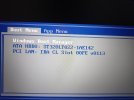Wanted to try out a Thinkpad but it won't somehow boot from a HDD with FreeBSD on it (that runs perfectly fine on another laptop).
The hard drive in question has gptboot on the boot partition showing under gparted on Ubuntu (guessing that matters).
Note: HDD has geli encryption (not sure if it matters much) - Worked fine on original laptop. The Thinkpad boots fine from a Ubuntu USB stick or a windows hard drive in same slot as current HDD.
How can this be fixed? Is this some kind of GPT issue?
The hard drive in question has gptboot on the boot partition showing under gparted on Ubuntu (guessing that matters).
Note: HDD has geli encryption (not sure if it matters much) - Worked fine on original laptop. The Thinkpad boots fine from a Ubuntu USB stick or a windows hard drive in same slot as current HDD.
How can this be fixed? Is this some kind of GPT issue?






